What comes to mind when you hear or see “limited stock” or “while stock lasts”?
A sale. A bargain. A good deal.
“Limited stock” and “while stock lasts” could elicit happy thoughts when we are shopping.
However, when it comes to traditional energy sources, fossil fuels like coal, crude oil, and natural gas, it means we’re running out of stock AND time.

We won’t be around for the next hundred or million years for these natural resources to get replenished.
When fossil fuels are burned for energy, they also emit significant amounts of carbon dioxide into the atmosphere, contributing to global warming and climate change.
Because of these two reasons, many energy companies have begun switching to renewable energy sources such as wind and solar.
To help address climate change issues, the Australian government is prioritising renewable energy in an effort to reduce Australia’s carbon emissions to 43% below 2005 levels by 2030 and reach its net zero target by 2050.
It’s no surprise, then, that the renewable energy industry is growing with shares of renewable energy companies now available on the Australian Securities Exchange (ASX), and there are also exchange traded funds (ETFs) that specialise in renewable energy stocks.
That brings us to the question:
As an investor, should you invest in renewable energy stocks?
Read on and find out if renewable energy stocks are good investment options for you.
Jump straight to…
What are Renewable Energy Stocks?
Let’s start by defining renewable energy.
Renewable energy (aka clean energy or green energy) refers to any method of producing energy with alternative resources to replace fossil fuels. These alternative energy sources are seen as environment-friendly and sustainable (will not be depleted).

Companies engaged in renewable energy generation, that is harnessing these renewable sources of energy, comprise ASX renewable or clean energy stocks.
Clean energy stocks can also refer to companies engaged in auxiliary technologies that will be vital to green energy transition.
Improved renewable technologies like battery storage, for example, can assist transportation networks in transitioning to electric vehicles, and smart grids can assist in reducing total consumption.
Last, but equally important, are companies that practise Environmental, Social, and Governance (ESG) which are also considered by some investors to fall under the clean energy category.
Although these companies are not involved in day-to-day renewable energy operations, their business practices are not harmful to the environment and contribute to reducing carbon emissions.
ESG investing is a type of investing that prioritises a company’s environmental and social impacts alongside its profits.
ESG is a corporate movement that encourages companies to be transparent, ecologically and socially responsible, and to practise good governance.
As a prospective investor, researching companies to invest in that aligns with your strategy and passion is an essential step in the investing process.
To have a deeper understanding of clean energy companies, let’s drill down the details of what they actually do. This can help inform your choices.
Renewable Energy Sources
There are many renewable energy producers and providers that fall under the renewable energy sector. Let’s have a look at the various renewable energy sources to identify these producers and providers.

HYDRO ENERGY
Hydroelectric energy is a type of renewable energy that generates electricity by harnessing the power of moving water.
With around 100 operational hydroelectric power plants and a total installed capacity of approximately 7800 megawatts (MW), much of Australia’s economically viable hydro energy resource has already been harnessed.
Australia’s hydroelectric power plants are concentrated in locations with the highest rainfall and elevation, primarily in New South Wales and Tasmania.
Hydro energy is especially essential in Tasmania, where 50 major dams, numerous lakes and 29 power stations with a total capacity of over 2600 MW generate a large portion of the state’s electricity.
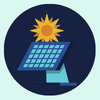
SOLAR POWER
Solar power is the energy produced by the sun’s heat and light, which is then transformed into electricity or utilised to heat air, water, or other substances. Solar energy can be converted into solar fuels such as hydrogen.
By the end of 2021, Australia had more than 22,800 MW of solar capacity installed. Each year, more solar photovoltaic (PV) energy is added than any other type of energy generation, owing largely to the substantial cost reductions realised in recent years. The global levelized cost of energy (LCOE) for big scale solar dropped by 85% between 2010 and 2020.

WIND ENERGY
Wind power entails harnessing the wind’s natural power to generate electricity. Wind turbines collect wind energy inside the swept region of its blades. The rotating blades power an electrical generator, which generates electricity to be exported to the grid.
By the end of 2021, Australia had almost 9,000 MW of electricity capacity from wind energy.
Wind power is currently the most affordable large-scale renewable energy source due to technological advances. Wind turbines are increasingly larger, more efficient, and incorporate intelligent technology.
As technology advances, fewer turbines are required to provide the same amount of energy, and wind farms are becoming more sophisticated in their adaptive capability.
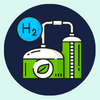
HYDROGEN
Hydrogen is the most common element in the universe and can be generated as a gas or liquid, or as a component of other materials.
It has a wide range of applications including transportation and heating fuel, energy storage, and as a raw ingredient in industrial processes.
In Australia, as is the case in much of the rest of the globe, hydrogen is mostly used as a raw ingredient in industrial processes. Renewable hydrogen utilisation in Australia could aid in the reduction of emissions from high-temperature industries as well as several transportation sectors. By 2023, Australia will be the first country in the world to use one of GE’s 9F hybrid gas-hydrogen turbines for grid electricity in 2023—an initiative which will help in decarbonizing power generation.
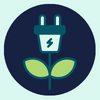
BIOENERGY
Bioenergy is a form of renewable energy that uses organic material as a source of energy for electricity generation. It’s also used as a direct source of heat for domestic, commercial and industrial purposes, including the production of liquid fuels for transport.
There are two types of biofuels: biomass and biogas.
Biomass is vegetable and animal derived organic materials, which are grown, collected or harvested for energy.
Biomass is a solid material, while biogas is a gaseous chemical produced by the Anaerobic Digestion process.
Biogas, aka renewable natural gas (RNG), is the gaseous byproduct of the decomposition of organic materials that has been purified.
By the end of 2021, Australia had almost 900 MW of electricity capacity from bioenergy.
Auxiliary Technologies for Renewable Energy
Energy efficiency was a big hurdle in the early years of harnessing green energy sources, and the biggest barrier back then was this inconvenient truth:
Renewable energy was expensive.
Fortunately, advances in renewable technology jump started the clean energy revolution.
BATTERY STORAGE
Batteries are an energy storage system that absorbs and releases energy on demand using chemical elements. The most common battery chemistry used to store electricity is lithium-ion.
When batteries are combined with renewable energy output, energy can be stored during times of low demand and dispatched during peak demand.
Battery storage for renewable energy is becoming more widely used in Australia, with a wide range of designs, functions, sizes, and locations.
Batteries are used in the following applications:
- The national grid of electricity (at both the transmission and distribution levels)
- ‘Behind the metre’ in electric vehicle charging, residential, commercial, or industrial settings
- The grid’s periphery (areas with low connectivity) or off grid (e.g. in microgrids)
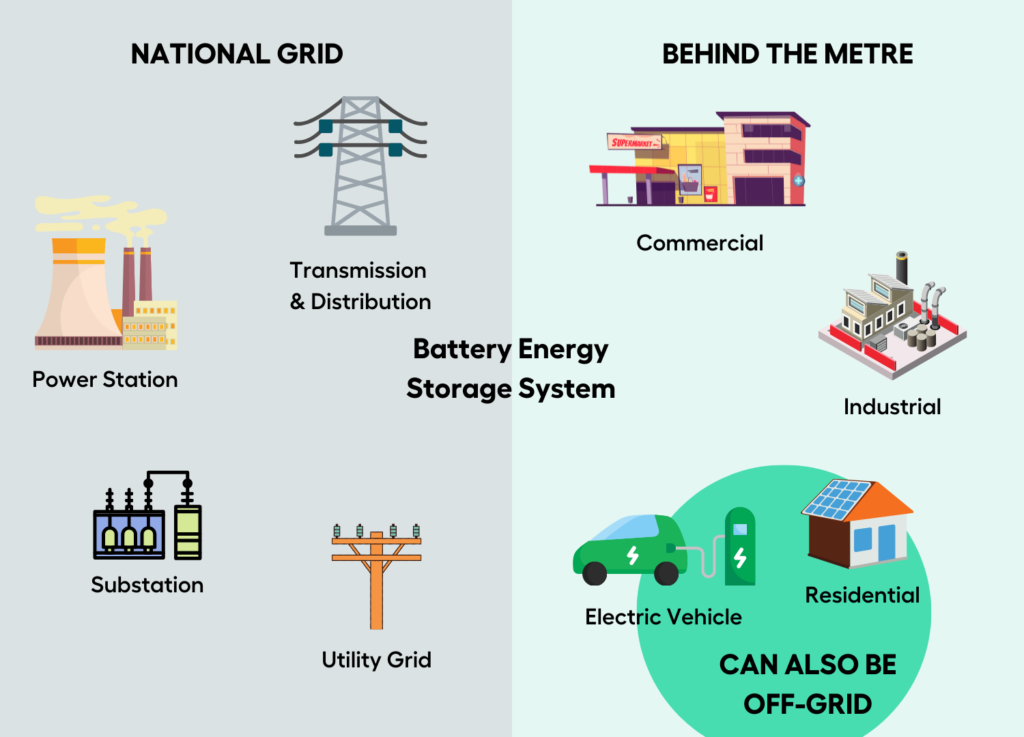
SOLAR PANELS
Solar thermal and solar photovoltaic are the two main subtypes of solar energy.
- Solar thermal technology turns sunlight into heat aka thermal energy, which can then be used for a variety of purposes, including the generation of steam to power an electrical generator or a refrigeration cycle.
- Solar photovoltaic (solar PV) technology turns sunlight directly into electricity using a semiconductor cell or solar cell. The process of transforming sunlight into electricity using PV systems emits no greenhouse gases.
A solar panel is normally made of solar cells enclosed in glass and an aluminium frame.
One or more solar panels can be installed to power a single light, to cover the roof of a home for household usage, or to form a large-scale solar farm capable of producing hundreds of megawatts of electricity.
Solar panels are now the most common type of solar PV technology; however, other varieties of solar PV, such as thin film solar panels integrated into buildings, flexible PV, and even PV paint, are being developed for specific uses.
Australia has the highest rate of solar power adoption in the world, with 30% of homes fitted with rooftop solar panels. That’s more than 3 million rooftop solar PV systems as of 31 January 2022.
ESG Companies
Sustainable or socially responsible investing involves taking into account environmental and social governance (ESG) considerations, and it can result in great profits.
By making sustainable investments, you are hitting two birds with one stone:
- You are harnessing your power to select a goal or result that is significant to you
- You are contributing in a small way but with a big impact on how businesses are reshaping the world.
The United Nations established the 17 Sustainable Development Goals in 2015 to address economic, social, and environmental concerns by 2030.
These goals serve as benchmarks for firms to meet their ESG targets, which include:
- Decarbonisation
- Availability and sustainability of clean water supply
- Improvement of human and labour rights
- Race and gender equality
ESG investing improved the transparency of many ASX 200 companies when reporting on environmental, social and governance risks, according to Louise Davidson, the chief executive of the Australian Council of Superannuation Investors (ACSI).
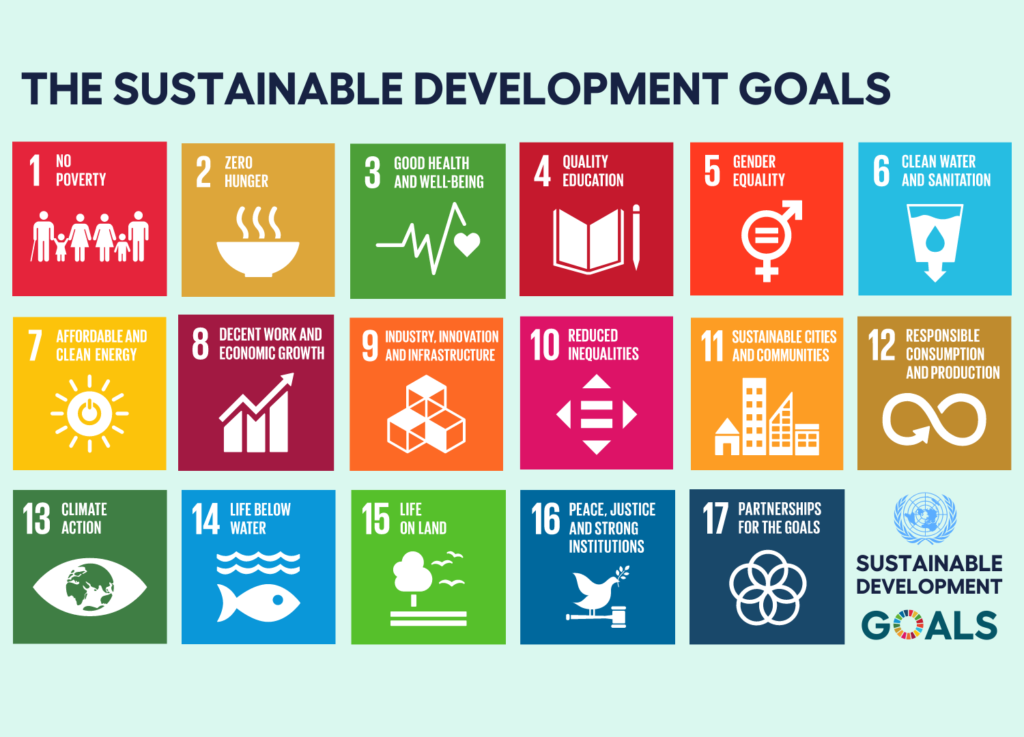
Now that you’re slightly familiar with what can be identified as renewable energy stocks, let’s look into their investment sustainability.
Investing in Renewable Energy: Trend or Good Idea?
As we’ve discussed earlier, investing in renewable energy goes beyond solar and wind. Investing in storage, transportation, electrification, and sustainability is also of prime importance.
Think about this:
Global energy demand rises year after year.
Total global energy consumption is predicted to increase by approximately 50% by 2050, driven by expanding economies and developing countries.
Meanwhile, scientists are raising the alarm about rising temperatures brought on by greenhouse gases such as carbon dioxide.
These two realities have prompted many countries, including Australia, to transition away from fossil fuels and attain net zero carbon emissions by 2050.
Investment in renewable energy projects reached new highs in 2021, mainly to new solar and wind power installations.
BloombergNEF estimates that solar and wind facilities will require an average of $1.5 trillion per year between 2026 and 2030 to achieve net-zero carbon emissions by 2050.
Locally, the Australian government plans to generate $76 billion in investments under its Powering Australia plan.
If anything, governments, and by extension businesses, worldwide are intent on making the transition to renewable energy a sustainable and rewarding venture.
Are Renewables Profitable?
That’s a good question, and a practical one if you are an investor. So, let’s take a look at data on renewable energy investment.
According to a report by The Centre for Climate Finance and Investment at Imperial College Business School in London and the International Energy Agency, the risk-return ratio for renewable energy is superior in both normal and crisis market conditions.
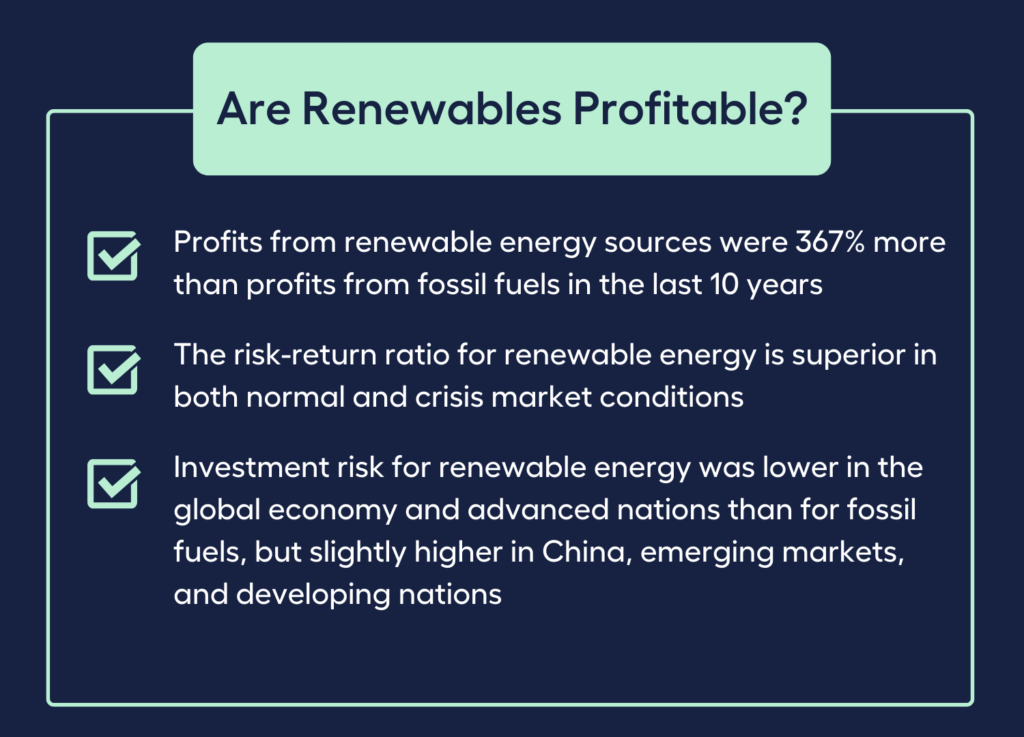
Global Energy Investing: Global Comparison of Investment Returns (March 2021)
Centre for Climate Finance & Investment
Imperial College Business School
The report reflects that in the last 10 years, profits from renewable energy sources were 367% more than profits from fossil fuels.
At the same time, investment risk for renewable energy was lower in the global economy and advanced nations than for fossil fuels, but slightly higher in China, emerging markets, and developing nations.
Best Green Energy Stocks to Buy
According to Canstar, the following are the top five most popular renewable equities on the ASX in 2021:
- Tilt Renewables Ltd (ASX: TLT)
- Infratil Ltd (ASX: IFT)
- Mercury NZ Ltd (ASX: MCY)
- Contact Energy Limited (ASX: CEN)
- Genesis Energy Ltd (ASX: GNE)
Tilt Renewables Ltd (ASX: TLT)
Tilt Renewables Ltd is an Australian company with wind and solar farms in Australia and New Zealand. The company went public in 2016 and has since built up a substantial wind and solar development pipeline.
Infratil Ltd (ASX: IFT)
Infratil Ltd invests in utilities and infrastructure companies in Australia and New Zealand, as well as worldwide (mainly in the United States and Europe). These investments mostly involve renewable energy, airports, and social infrastructure.
Mercury NZ Ltd (ASX: MCY)
Mercury NZ Ltd generates renewable energy from a variety of sources and also provides energy services and goods to retail and wholesale customers. MCY is a renewable energy company established in New Zealand. The company focuses on electricity investment as well as the development and production of energy-related services.
Contact Energy Limited (ASX: CEN)
Contact Energy is committed to investing in a diverse portfolio of renewable power generation assets in order to meet New Zealand’s energy requirements. The company’s principal operation is to sell power to commercial wholesale and industry partners. In addition, the corporation seeks to provide natural gas, electricity, broadband, and other associated services to the general public.
Genesis Energy Ltd (ASX: GNE)
Genesis Energy is a New Zealand firm that generates and sells electricity, natural gas, and LPG (liquified petroleum gas) to consumers worldwide. The company has three divisions: retail, Kupe Oil & Gas, and wholesale. It serves residential, commercial, and industrial customers.
How to Invest in Renewables
Are you considering investing in a renewable energy company, a company that supports renewable energy, or an ESG company?
Here are 4 Ways to Invest in Renewables:
1. Renewable energy shares on the ASX
Shares in renewable energy companies that are publicly traded on the Australian stock exchange can be purchased.
2. International shares
Some of the largest renewable energy companies are listed on stock exchanges abroad such as the United States and Canada. These can be obtained through a broker who specialises in international shares.
3. Sustainability exchange-traded funds (ETFs)
ETFs are a collection of shares, generally hundreds, that often track an index of stocks. Because Australia’s renewables market is still extremely tiny, there are few possibilities for renewable energy ETFs on the ASX at the moment. On worldwide exchanges, there are numerous options.
4. Micro invest
Some investment applications provide sustainability funds, which may allow you to directly invest in renewable energy companies.
What is the Future of Green Energy Stocks?
Clean energy stocks have become popular because of advances in technology that make renewable energy cheaper to produce.
Meanwhile governments worldwide are dedicated to combating climate change by producing cleaner energy and investing billions in renewable natural sources and alternative energy resources.
If you’re thinking of making renewable investments, have a chat with My Money Sorted to get a better understanding of the market.
Many people may be unaware of this…but just like you, 41% of Aussies intend to get financial advice rather than going it alone, according to an Australian Securities and Investments Commission (ASIC) report.
Find the right Financial Adviser for you with the help of My Money Sorted.
When you book a call with My Money Sorted, you’ll:
✓ get a better understanding of your personal finance and investment options
✓ have an idea of the experts you can call on to help you reach your goals
✓ be matched with the right financial adviser who can help simplify your investment options
My Money Sorted is your stress-free pathway to getting ahead with your money.
Here’s what your journey will look like:
Step 1: Start off with a quick investment alternatives session with My Money Sorted
Step 2: Get matched with a licensed Finance Adviser that’s right for your money situation
Step 3: Take the first step towards your money goals with a clear and sound roadmap prepared by an experienced Financial Adviser
It’s that easy!
Want to Invest in a Sustainable Future? Speak with My Money Sorted to Find the Right Financial Advice.






